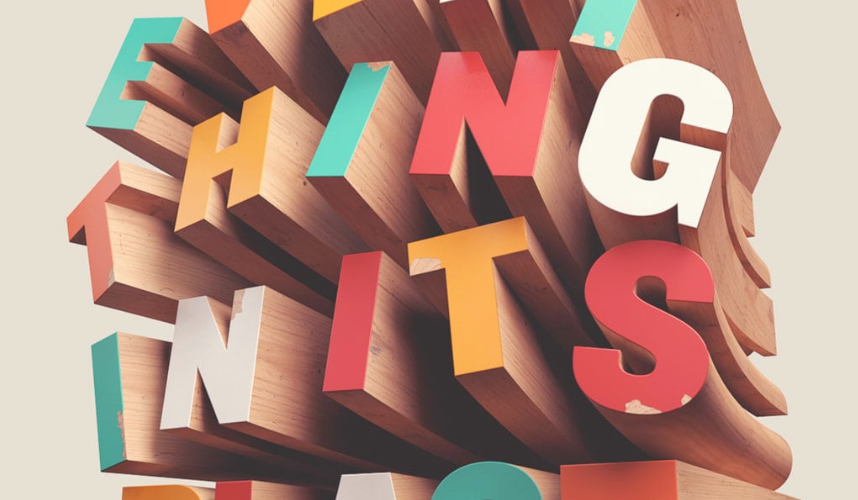Imagine a world where words leap off the screen, where text isn’t just read but experienced. Welcome to the thrilling realm of 3D typography—a design trend that’s transforming how we interact with words. From eye-catching advertisements to immersive virtual environments, 3D typography is redefining the boundaries of visual communication. This article dives into the exciting world of 3D typography, exploring its evolution, applications, and why it’s the future of design.
Contents
What is 3D Typography?

3D typography is the art of creating text with depth, volume, and dimension. Unlike flat, traditional fonts, 3D typography uses shading, lighting, and perspective to make letters appear as if they exist in real space. When combined with immersive technologies like augmented reality (AR) and virtual reality (VR), 3D typography becomes an interactive experience, allowing users to engage with text in entirely new ways.
The Rise of 3D Typography

The journey of 3D typography began with simple drop shadows and beveled edges in early graphic design software. Today, thanks to advancements in 3D modeling tools and AR/VR platforms, designers can create stunning, lifelike text that captivates audiences. From movie titles to social media posts, 3D typography is everywhere, and it’s only getting bigger.
Why 3D Typography is Trending
-
Visual Impact
3D typography grabs attention like nothing else. Its depth and realism make it perfect for branding, advertising, and digital content.
-
Immersive Experiences
With AR and VR, 3D typography can be integrated into interactive environments, creating unforgettable user experiences.
-
Versatility
Whether it’s a website, a video game, or a physical installation, 3D typography adapts seamlessly to any medium.
- Innovation
As technology evolves, so does 3D typography. Designers are constantly pushing the limits, creating text that’s not just seen but felt.
Applications of 3D Typography
1. Advertising and Branding
Brands are using 3D typography to create bold, memorable campaigns. Imagine walking past a billboard where the text pops out in 3D or using an AR app to see a brand’s logo come to life.
2. Gaming and Entertainment
Video games and movies are leveraging 3D typography to enhance storytelling. Titles, subtitles, and in-game text are designed to blend seamlessly with the virtual world, adding to the immersion.
3. Web and App Design
Websites and apps are incorporating 3D typography to create visually engaging interfaces. Animated 3D text can guide users, highlight key information, or simply add a wow factor.
4. Art and Installations
Artists are using 3D typography to create interactive installations and digital art pieces. These works often feature text that responds to viewer movements or environmental changes.
Tools for Creating 3D Typography
- 3D Design Software
Programs like Blender, Cinema 4D, and Maya allow designers to create intricate 3D typography with realistic textures and animations. - AR/VR Development Platforms
Tools like Unity, Unreal Engine, and Spark AR make it possible to integrate 3D text into AR/VR experiences. - Web Technologies
WebGL and CSS 3D transformations enable designers to bring 3D typography to websites and web applications.
Challenges of 3D Typography
While 3D typography offers exciting possibilities, it also comes with challenges:
- Performance Issues
High-quality 3D text can be resource-intensive, potentially slowing down websites or apps. - Accessibility
Complex 3D designs may not be accessible to all users, particularly those with visual impairments. - Learning Curve
Creating 3D typography requires specialized skills and software, which can be a barrier for some designers.
The Future of 3D Typography
The future of 3D typography is bright and full of potential. Here’s what to expect:
- Holographic Typography
Advances in holography could enable text to appear as fully three-dimensional holograms, visible without the need for AR/VR headsets. - AI-Generated 3D Text
AI tools will streamline the creation of 3D typography, allowing designers to generate custom fonts and animations with minimal effort. - Wider Adoption
As AR glasses and VR headsets become more common, 3D typography will become a standard part of our daily interactions.
Conclusion
3D typography is more than just a design trend—it’s a revolution in how we experience text. By combining artistry with cutting-edge technology, designers can create text that’s not only visually stunning but also deeply interactive and meaningful. Whether in advertising, entertainment, or everyday life, 3D typography is shaping the future of visual communication. So, get ready to see the world in a whole new dimension—because 3D typography is here to stay!
